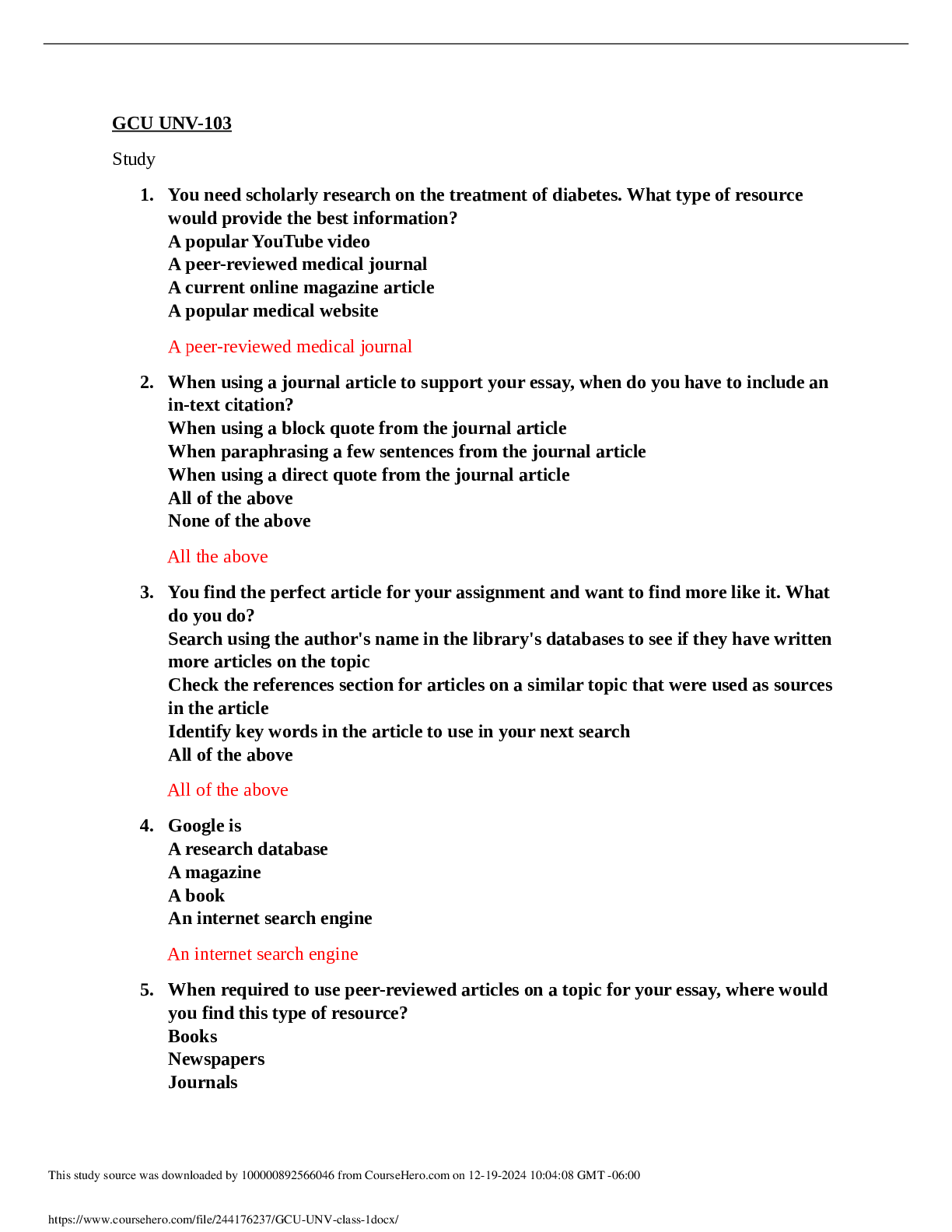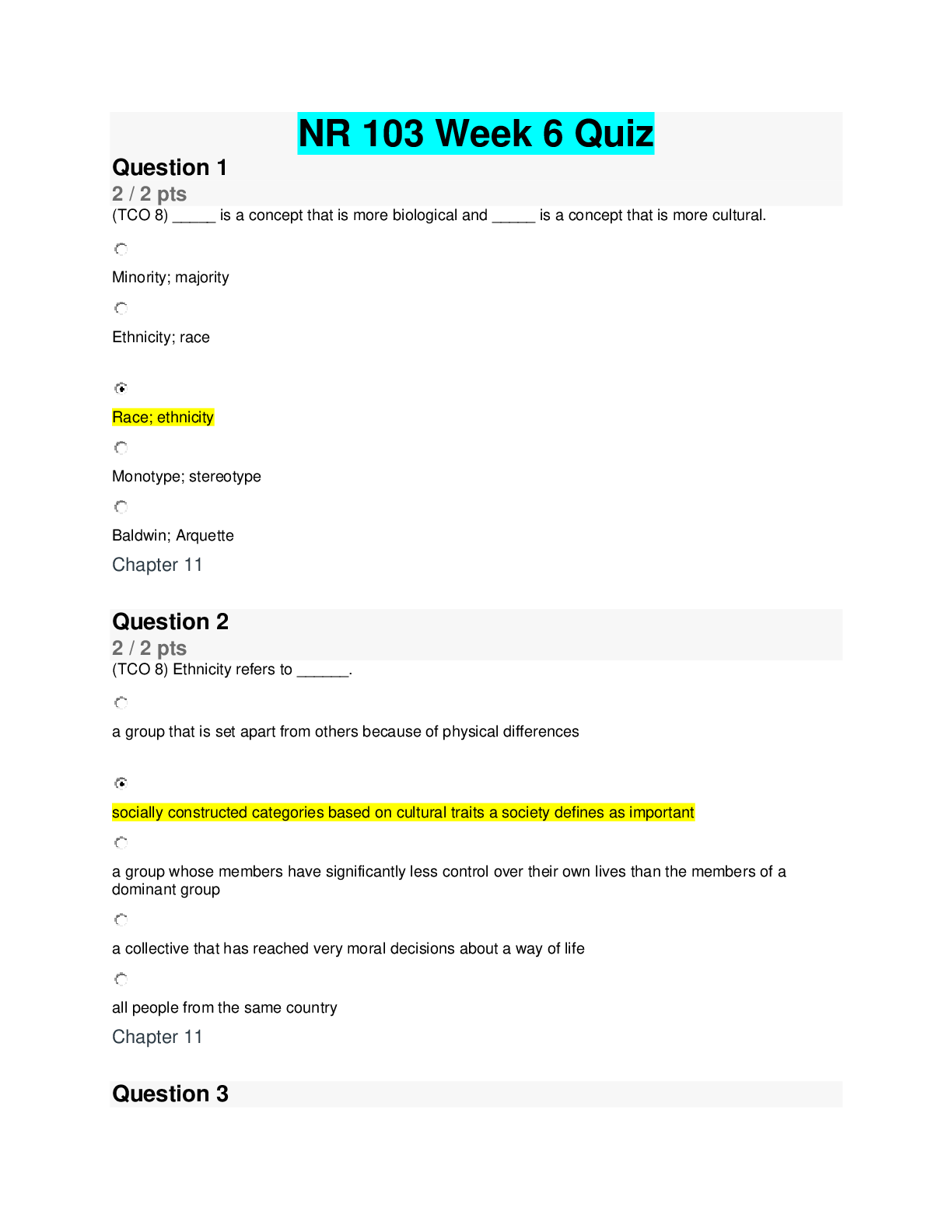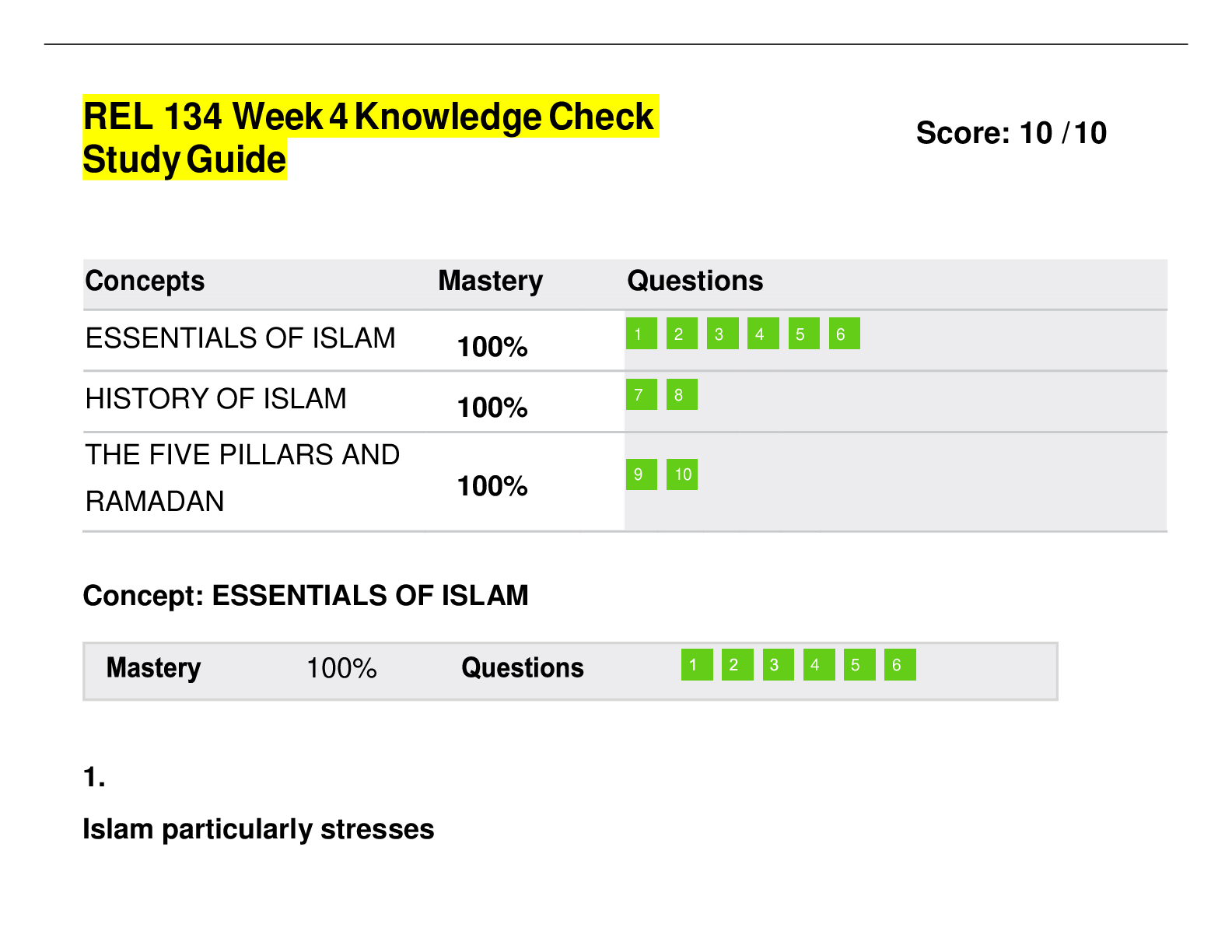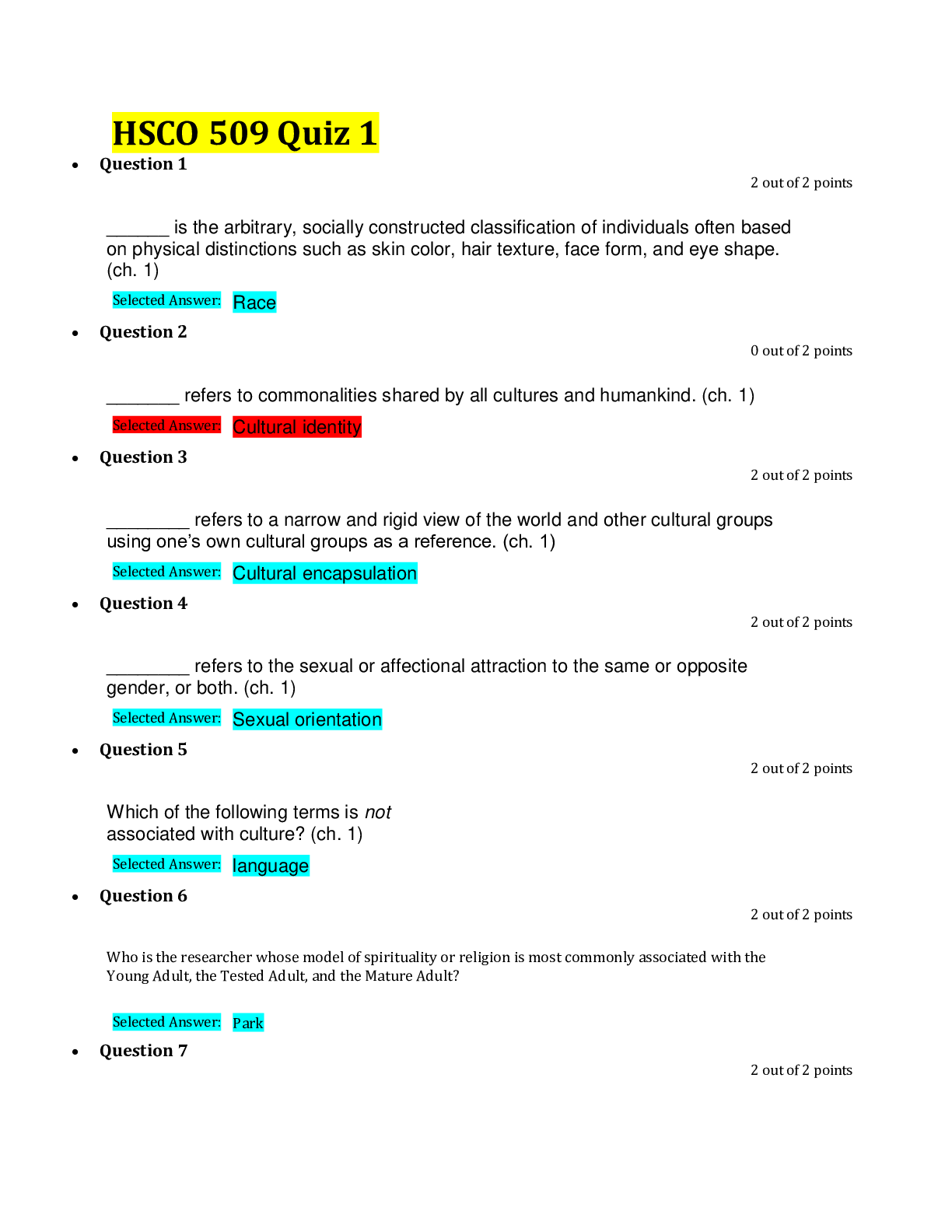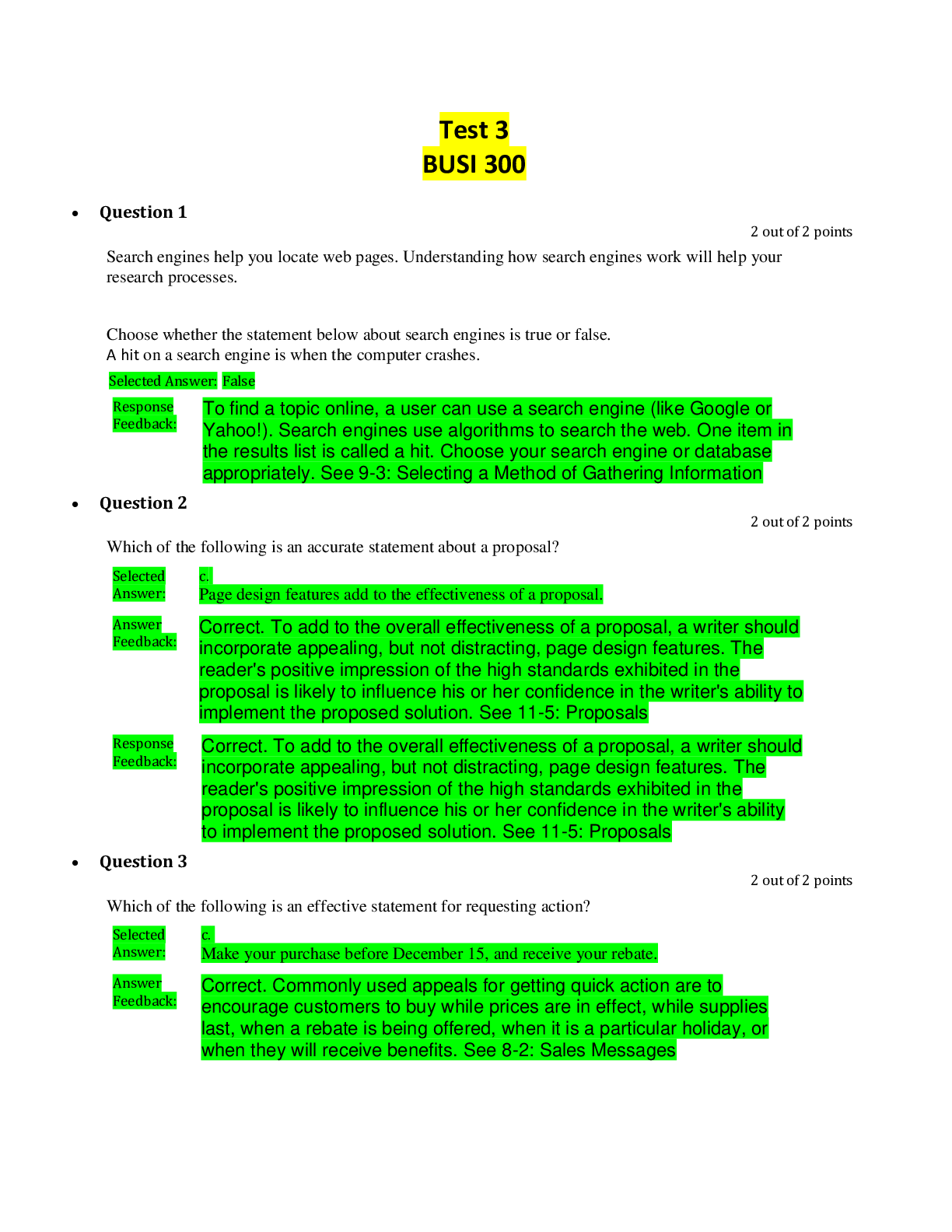BIO 260 All Weekly Quizzes | Answers (Weeks 1 – 7) Latest.
Document Content and Description Below
BIO 260 Weekly Quizzes Answers (Weeks 1 – 7) WEEK 1 QUIZ 1. Question : (TCO 1) Match each of the following terms to its brief definition. Question 2. Question : (TCO 1) What are some o... f the possible causes of disease? Name four and give an example for each. Question 3. Question : (TCO 2) How would you distinguish the difference between signs and symptoms? Can you give an example of each? Question 4. Question : (TCO 1) A patient with diabetes is admitted to the hospital with diabetic nephropathy, which develops into renal failure. The renal failure would be called a: Comorbidity Complication Sequela Syndrome Question 5. Question : (TCO 1) A prediction of the course of a disease is called the: Diagnosis Pathogenesis Prognosis Etiology Instructor Explanation: Ch. 1, page 4 Question 6. Question : (TCO 1) A 12-year-old patient is brought to the doctor because of complaints of headache, dizziness, fever, and blurred vision since the night before. Which of these symptoms is objective (a sign)? Headache Dizziness Fever Blurred vision Instructor Explanation: Ch. 1, page 4 Question 7. Question : (TCO 2) Another name for a vaccine is: An antibody A toxoid An antigen Immunity Question 8. Question : (TCO 2) A little girl is bitten by a squirrel. She is given shots to protect her against possible rabies. What kind of immunization did she receive? Natural Active artificial Passive artificial A vaccination Question 9. Question : (TCO 2) A normal respiration rate (per minute) is: 5-10 80-100 16-18 68-88 Question 10. Question : (TCO 2) On a physical exam, tinnitus means: Excessive hair growth Ringing in the ears Difficulty swallowing Inflamed throat Question 11. Question : (TCO 3) A hematocrit higher than 50 percent would indicate what about a patient's blood? It is too thick It is too thin It has low oxygen It is infected Question 12. Question : (TCO 3) A coronary angiogram is performed during which procedure? A stress test Echocardiogram Cardiac catheterization Electrocardiogram Question 13. Question : (TCO 3) Which of the following is a cardiac enzyme? Hemoglobin Troponin Calcium Cholesterol WEEK 2 QUIZ 1. Question : Match each of the following terms to its brief definition: Question 2. Question : (TCO 5) Why is it that cancer is so often a fatal disease? What can be done to decrease the mortality rate? Question 3. Question : (TCO 4) Describe four different types of infectious agents and an example of a disease caused by each agent (excluding helminths). Question 4. Question : (TCO 4) Another term for infectious disease is: Communicating Communal Communicable Combined Question 5. Question : (TCO 4) The single most important means of preventing the spread of nosocomial infections is: Isolation of patients Hand-washing The use of prophylactic antibiotics Wearing masks Question 6. Question : (TCO 4) Infections that are acquired in the hospital are called _______ infections. occupational confinement social nosocomial Question 7. Question : (TCO 4) The best way to prevent a viral infection is by: Vaccination Prophylactic antibiotics Isolation Quarantine Question 8. Question : (TCO 5) Family history is the single most important risk factor in this cancer: Ovarian Lung Prostate Kidney Question 9. Question : (TCO 5) HPV (Human Papilloma Virus) is a risk factor for what cancer? Malignant melanoma Cervical Prostate Bladder cancer Question 10. Question : (TCO 5) A high-fat diet is a risk factor for which cancer? Stomach Liver Colon Lung Question 11. Question : (TCO 5) A _________ is a benign tumor of the muscle. myoma myeloma myosarcoma myelinoma Question 12. Question : (TCO 6) Diseases such as diabetes, allergies, and epilepsy are categorized as: Familial Hereditary Congenital Contagious Question 13. Question : (TCO 6) People with hemophilia: Bleed faster than normal Bleed more profusely than normal Bleed longer than normal Bleed at the slightest injury WEEK 3 QUIZ 1. Question : Match the term and definition: Question 2. Question : (TCO 7) Analyze sickle cell anemia disease in terms of (a) etiology, (b) symptoms, (c) treatment, and (d) prognosis. Question 3. Question : (TCO 8) What causes congestive heart failure? What are the symptoms? Question 4. Question : (TCO 7) A diet that is low in fresh fruits and vegetables causes which type of anemia? Vitamin B12 deficiency Folic acid deficiency Iron deficiency Hemolytic Question 5. Question : (TCO 7) In Polycythemia vera, there is an increased number of: erythrocytes. leukocytes. platelets. all blood cells Question 6. Question : (TCO 7) A normal count for WBCs on a CBC is: 4-6 million 45% 5 to 10 thousand 150,000 to 300,000 Question 7. Question : (TCO 8) Which of the following statement is CORRECT? Highly oxygenated blood is found in the right side of the heart. The right ventricle pumps blood through the aorta. The pulmonary artery carries low-oxygen blood to the lungs. The pulmonary artery carries high-oxygen blood back to the heart. Question 8. Question : (TCO 8) What acts as the anatomical pacemaker of the heart? Purkinje's fibers Sino-atrial node Vagus nerve Mitral valve Question 9. Question : (TCO 8) Contraction of the ventricles is called ________. systole stasis diastole syncope Question 10. Question : (TCO 8) The function of the right side of the heart is to pump blood to the _______. vena cava aorta lungs heart muscle Question 11. Question : (TCO 8) ______ are two names for the left heart valve. Semilunar and aortic Aortic and bicuspid Mitral and tricuspid Mitral and bicuspid Question 12. Question : (TCO 8) Listening through a stethoscope for abnormal sounds is called: Auscultation Percussion Audiology Echocardiography Question 13. Question : (TCO 8) Occlusion or rupture of a cerebral artery aneurysm will result in: CVA CHF MI All of the above WEEK 4 QUIZ 1. Question : Match each of following terms to its brief definition. Question 2. Question : (TCO 10) Analyze the differences between Hepatitis A and Hepatitis B in terms of etiology, symptoms, and prognosis. Question 3. Question : (TCO 11) What is chronic obstructive pulmonary disease? Question 4. Question : (TCO 10) How is hepatitis C spread? By ingestion of contaminated food Through blood contact Airborne (coughing and sneezing) By drinking contaminated water Question 5. Question : (TCO 10) Which of these cancers has a poor prognosis, as surgery, chemotherapy, and radiation are seldom successful? Colon cancer Pancreatic cancer Stomach cancer Duodenal cancer Question 6. Question : (TCO 10) Which one is NOT a symptom of advanced cirrhosis? excessive hair growth abdominal ascites leg edema redness of the palms Question 7. Question : (TCO 10) Infection by Helicobacter pylori is a major cause of _______. cholecystitis pancreatitis gastric ulcers ulcerative colitis Question 8. Question : (TCO 10) Where does the greatest amount of digestion occur? stomach large intestine small intestine mouth Question 9. Question : (TCO 11) Bullous formation and a "barrel chest" are characteristic of which disease? Tuberculosis Emphysema Lobar pneumonia Asthma Question 10. Question : (TCO 11) The etiology of cystic fibrosis is: viral infection bacterial infection hereditary long term exposure to irritants such as smoke Question 11. Question : (TCO 11) Antibiotics are effective in the treatment of __________. influenza the common cold strep throat hay fever Question 12. Question : (TCO 11) Expanded lungs and a "barrel chest" are symptoms of: acute bronchitis asthma tuberculosis emphysema Question 13. Question : (TCO 11) A tracheotomy is sometimes performed to relieve: acute bronchitis stage II tuberculosis COPD status asthmaticus WEEK 5 QUIZ 1. Question : Match each of the following terms to its brief definition. Question 2. Question : (TCO 9) Explain the condition of hydronephrosis. What are the causes of this condition? How is it treated? Question 3. Question : (TCO 14) What is the origin of cryptorchidism? What are some of the later complications for which it is a risk factor? Question 4. Question : (TCO 9) Hydronephrosis is caused by: a bladder infection a congenital condition renal failure urinary tract obstruction Question 5. Question : (TCO 9) Which condition is treated with hemodialysis? Pyelonephritis Hydronephrosis Glomerulonephritis End-stage renal disease Question 6. Question : (TCO 9) The etiology of polycystic kidney disease is: hereditary inflammatory idiopathic traumatic Question 7. Question : (TCO 9) A "staghorn" is a: congenital renal cyst kidney stone hyperplastic prostate kidney tumor Question 8. Question : (TCO 14) Toxemia of pregnancy is also known as_______. cephalopelvic disproportion cryptorchidism preeclampsia gestational diabetes Question 9. Question : (TCO 14) A common symptom of endometriosis is menorrhagia, which means: pelvic pain excessive bleeding during menses bleeding in between normal menstrual periods the formation of fibroids Question 10. Question : (TCO 14) luid-filled sacs within the breast tissue are characteristic of: fibrocystic disease fibrous adenomas cystic fibrosis adenocarcinoma Question 11. Question : (TCO 14) Another term for uterine fibroids is: dermoid cyst teratoma ovarian cyst leiomyoma Question 12. Question : (TCO 14) In this condition, the fetal testes have remained in the abdominal cavity and did not drop down into the scrotum before birth. epididymitis prostatic hypertrophy vasectomy cryptorchidism Question 13. Question : (TCO 14) The PSA and DRE are screening tests for: cervical cancer testicular cancer ovarian cancer prostate cancer WEEK 6 QUIZ 1. Question : Match each of the following terms to its brief description Question 2. Question : (TCO 12) Distinguish between Diabetes Mellitus Type I and Diabetes Mellitus Type II in terms of etiology, risk factors, and treatment. Question 4. Question : (TCO 12) The __________ gland is controlled by the hypothalamus. thyroid parathyroid pituitary adrenal Question 5. Question : (TCO 12) This gland produces hydrocortisone. Pituitary Thyroid Adrenal Parathyroid Question 6. Question : (TCO 12) An excess of parathormone causes high levels of ________ in the blood. sodium iodine potassium calcium Question 7. Question : (TCO 12) A "moon face" is a symptom of: Cushing's disease Addison's disease myxedema Grave's disease Question 8. Question : (TCO 12) This gland produces TSH. Thyroid Pituitary Adrenal Parathyroid Question 10. Question : (TCO 13) A patient with bipolar disease experiences extreme mood swings of: anxiety and depression elation and depression anxiety and phobia depression and tranquility Question 11. Question : (TCO 13) Which of these descriptions fits a narcissistic personality? They have irrational fears They expect to be admired by others They are prone to substance abuse They have a very poor self-image Question 12. Question : (TCO 13) ADHD is the combination of: depression and anxiety euphoria and depression binging and purging inattention and impulsive behavior Question 13. Question : (TCO 13) A high level of anxiety combined with the repetition of meaningless ritualistic behaviors is characteristic of: schizophrenia bipolar disorder post-traumatic stress disorder obsessive-compulsive disorder WEEK 7 QUIZ Grade Details - All Questions Question 2. Question : (TCO 16) Summarize the risk factors, physiological changes, diagnostic methods, and treatment for osteoporosis. Question 3. Question : (TCO 15) Describe the risk factors and appearance of malignant melanoma. Question 4. Question : (TCO 16) The most common type of arthritis is: osteoarthritis gouty arthritis rheumatoid arthritis ankylosing arthritis Question 5. Question : (TCO 16) A common fracture of long bones seen in children is called: spiral fracture impacted fracture fibrous fracture greenstick fracture Question 6. Question : (TCO 16) Which disease is hereditary? Rheumatoid arthritis Muscular dystrophy Myasthenia gravis Rickets Question 7. Question : (TCO 16) Cancer of the bone is: osteomalacia osteoma osteitis deformans osteosarcoma Question 8. Question : (TCO 15) "A slow growing, generally non-metastasizing tumor" best describes: squamous cell carcinoma malignant melanoma basal cell carcinoma impetigo Question 9. Question : (TCO 15) The medical term for bed sores is: cellulitis impetigo carbuncles decubitus ulcers Question 10. Question : (TCO 15) Pediculosis describes: A fungal skin rash chronic dandruff lice infestation an allergic reaction Question 11. Question : (TCO 15) Skin cancer is diagnosed by: biopsy x-ray physical exam symptoms Question 12. Question : (TCO 15) Another name for atopic dermatitis is: eczema psoriasis vitiglio rosacea Question 13. Question : (TCO 15) Port wine, cherry, and strawberry are all names given to: rosacea benign keratoses ringworm birthmarks [Show More]
Last updated: 7 months ago
Preview 7 out of 42 pages

Loading document previews ...
Buy this document to get the full access instantly
Instant Download Access after purchase
Buy NowInstant download
We Accept:

Reviews( 0 )
$10.00
Can't find what you want? Try our AI powered Search
Document information
Connected school, study & course
About the document
Uploaded On
Feb 25, 2020
Number of pages
42
Written in
Additional information
This document has been written for:
Uploaded
Feb 25, 2020
Downloads
0
Views
122

